If you subscribe to Netflix then you’ve probably heard of or watched the increasingly popular “HGTV-esque” television series, Tidying Up with Marie Kondo released in January 2019. Each episode features families struggling with decluttering challenges and Marie coaching them via her KonMari™ Method-a Japanese way of organizing.
Binge watch a few episodes of Tidying Up and you may find yourself recommitting to your New Year’s resolution to declutter. But what does decluttering actually look like in reality? Can you manage your own tidying up process and still maintain your emotional well-being, or should you hire a professional organizer?
Consulting a Professional
We’ve put together some candid feedback gleaned from Tidying Up, as well as helpful tips from professional organizer, Traci Olivares of Totally Organized in Dallas, Texas.
According to Traci, we don’t use 80 percent of the stuff we own. (Yikes!) We generally don’t worry about (or even think about) all that stuff when we have ample storage for it. The real stress begins when we have to move that stuff to a new home or relocate it within an existing home due to space needs. So where do you begin on your tidying up to totally organized journey? If you have no idea, then begin by following Marie Kondo’s KonMari™ Method.
AN OVERVIEW OF THE KONMARI™ METHOD
(Further detailed in Marie’s books, linked below):
SORT
This process is a personal journey and therefore you have to have a certain level of self-motivation and drive. You also need to take ownership for your messes. While Marie coaches her clients during this process, she doesn’t do any of the work for them.
Sort through your belongings by the categories listed below rather than by location.
- Clothes
- Books
- Papers
- Miscellaneous (Everything else such as kitchen, garage, bathroom, kids’ stuff, office, etc.)
- Sentimental (this is the most difficult category to sort but by the time you get to it, you’ll understand how to organize and can be more effective)
Complete each of the five sorts above in individual sittings. Each step may create a mountain of stuff and will likely cause you some stress. But that is the idea. Seeing all of your stuff in one place is a bit of shock therapy that, in the end, will allow you to look at your now empty space in a new light.
ASK
Go through your items one-by-one and ask yourself these questions:
- How does this make me feel?
- Does this object spark joy?
- Am I going to carry this item into my future?
Use a favorite item as your benchmark. Do the other pieces give you the same type of joy as your favorite item? If not, then get rid of them. According to Kondo’s website, “Keep only those things that speak to the heart, and discard items that no longer spark joy. Thank them for their service – then let them go.”
GIVE THANKS
While it sounds silly, Marie suggests that you hold each item you are getting rid of and give thanks for it. This is a display of gratitude and positive energy. In doing so, you will relieve yourself of the guilt of never wearing/using the item, or getting rid of something that was a gift, a hand-me-down, or that has just been with you for a very long time.
KEEP & ORGANIZE
Once you have sorted and purged, it is equally important that you find a system for putting things back. A professional organizer like Traci can provide guidance for sustainable systems.
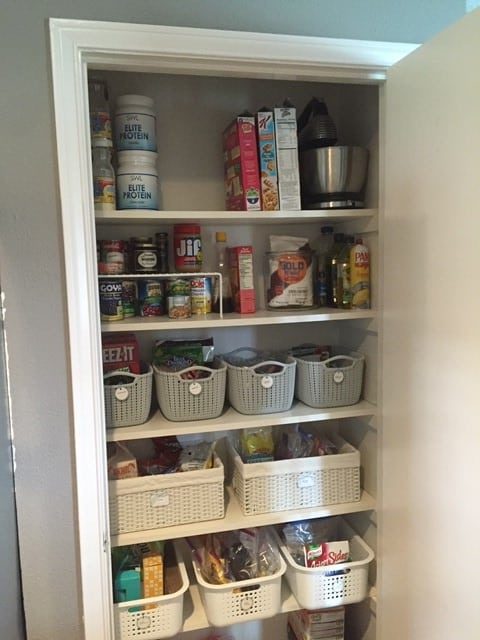
Sorting food items in your kitchen pantry can make food prep faster. Photo: Traci Olivares
SO HOW REALISTIC IS THAT???
TRACI OLIVARES’ TIPS
Traci first became motivated towards professional organizing when she became a mom. She found it was difficult for other moms to enjoy their families, get out and live their lives, and take on outside responsibilities when they were overwhelmed. Traci knew by helping them declutter and organize their lives she could also help them create a peaceful space to live their lives.
As a professional organizer, Traci spends about 70 percent of her time hands-on helping clients go through the decluttering and reorganization process. Oftentimes, clients don’t want (or don’t have the time) to do some of the overwhelming tasks so Traci tackles those projects for them.
VISUALIZE YOUR RESULTS
Determine your reasons for wanting to declutter. Do you want less stress, an easier time getting ready in the morning, more independent kids, more time to entertain and have friends in your home, a better relationship with your spouse? Visualize in as much detail as possible what you want your home and life to look and feel like after you tidy up.
TAKE INVENTORY
Look at your house as a whole and take inventory of your stuff and what the best storage solutions are. Your goal is to get the right items into the right rooms, so zone those areas out. For example: cleaners, brooms, mops, and other utility items should be stored in a laundry or utility room. Craft items should be stored at the point of use such as in a craft room or kitchen pantry (if your children do crafts at the kitchen table).
SORT
Traci’s clients often embark on their organizational processes at different rates than the “mountain-of-stuff-shock-therapy” found with the KonMari™ method. “Twenty years of accumulation is a process that won’t disappear overnight, so don’t take on too much at once,” says Traci. She encourages her clients to, “break the work into smaller sessions so it’s not overwhelming,” making sure there’s enough time to complete each tidying up project.
Traci personalizes the process to each homeowner’s reasons and needs. For example, if your disorganized office is causing you the greatest stress and anxiety, then start there.
GATHER AND CATEGORIZE
- Don’t make the mistake of just organizing individual drawers or cupboards without examining the location of the items in relation to where and how often they get used.
- Gather up and group items within your home into “like kind” categories to really see what you are dealing with. For example, when you are ready to organize your office, gather all of the office supplies, books, papers, pens, pencils, etc. from around your home into your office since that is likely where they will ultimately be used.
- By gathering and grouping you will free up space in the rooms where those items previously lived. Additionally, everyone will now know where “that thing” goes. This also helps you visualize when you have too many of those items and need to get rid of some.
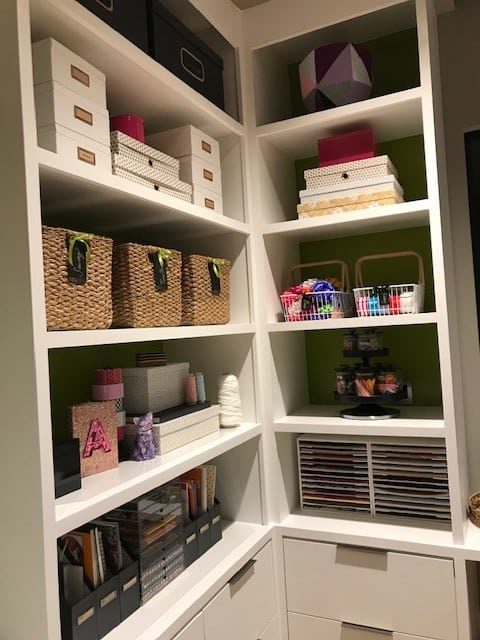
Craft rooms benefit from sorting and grouping “like kind” items together. Photo: Traci Olivares
ASK and THANK
Psychology plays a big role in our reasons for holding on to things. Acknowledge why you might be resisting letting go and give yourself permission to change.
As with Kondo’s method, ask yourself if the things in your home spark joy. Keep only those items that you love, that bring you happiness, and that you want to have with you into the future. Express gratitude vs. guilt towards the items leaving your home. Giving items away is giving someone else the opportunity to use and enjoy those things.
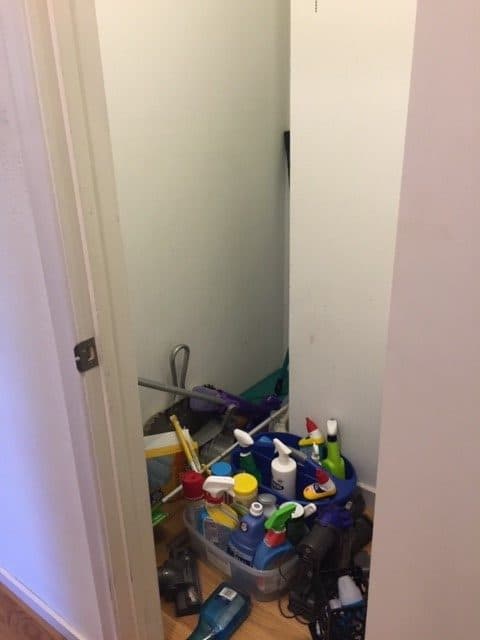
Utility Closet Before
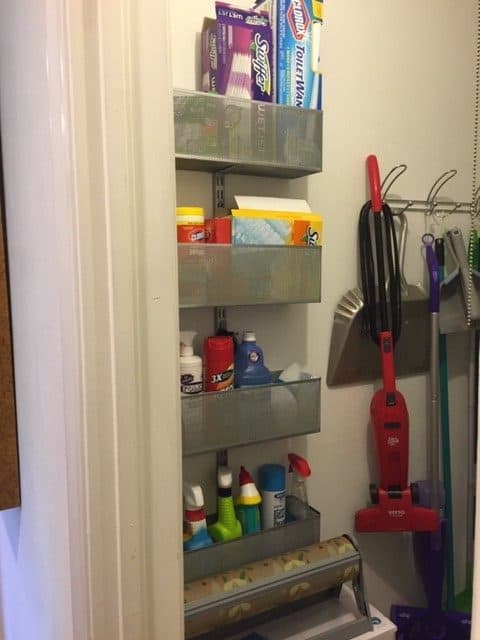
Utility Closet with storage systems. Photos: Traci Olivares
ORGANIZE
- Determine what your goal is, what the purpose of your space is, and how you want to live.
- Look at your empty spaces in a new way and define places and methods for storing items in the future. This will provide a better chance that items will get put back in the right places.
- Set your storage spaces up to be visually appealing, peaceful, functional, etc.
- Start with your personal space and belongings such as clothing. Keep in mind that the clothing items that get the most use are generally stored on top (oftentimes stacked on top of those items that are never seen or worn). Folding allows you to fit more items vs. when clothing is just tossed into a drawer or basket.
- Limit the number of items that fit in one space. Dedicate a specific location or container for things. When those areas are full, you’ll know that you don’t need more of those items (for example, light bulbs, batteries, paper towels, cleaners, etc.). Only keep a reasonable amount of useful items.
- Storage systems must be sustainable and consistent – and all family members need to be on board with your systems. Don’t use systems you can’t maintain and don’t set yourself up for failure.
- Set aside a daily “pick up” time (for you and your kids) to deal with items such as shoes, mail, dirty dishes, toys, etc. Don’t let clutter build up and create a bigger mess.
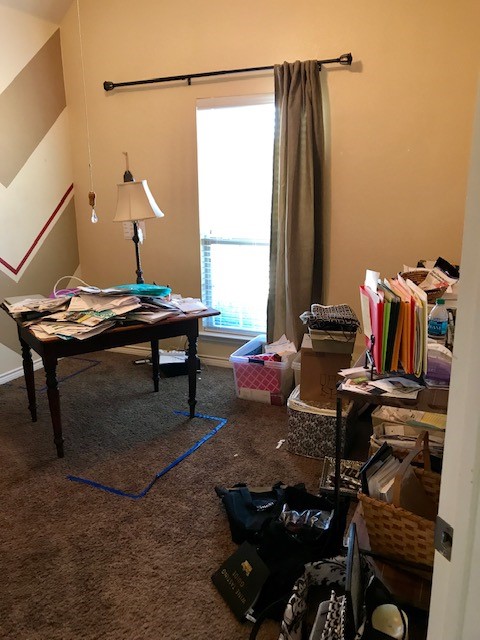
Home Office before
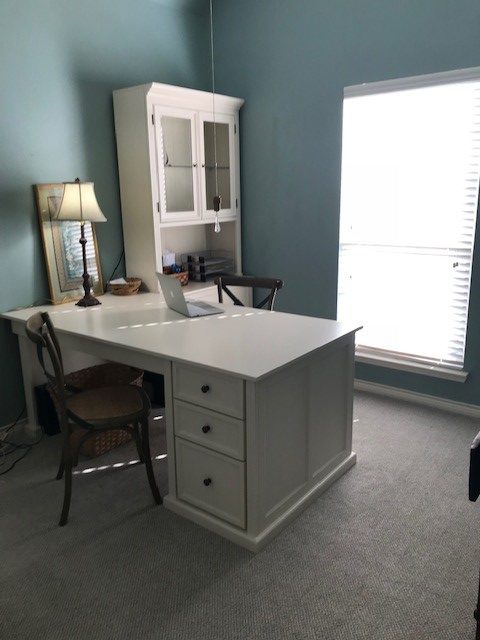
Organized, tidy office. Photos: Traci Olivares
Our blog, How to Declutter Your Home and Restore Your Joy provides additional suggestions for sorting, purging, donating, and organizing your things so you can sleep at night and restore your joy!
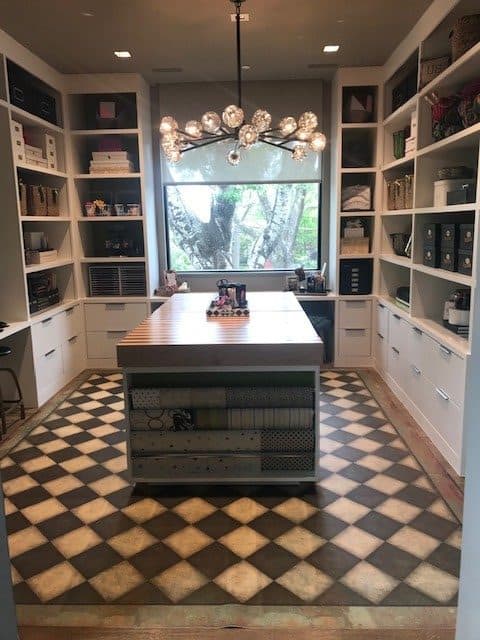
Creativity will flow if your craft room is organized, tidy, and has everything in its place. Photo: Traci Olivares
 You can listen to Laura and Holly’s podcast interview with Traci Olivares, Tidying up with Marie Kondo: Expectations vs. Reality HERE.
You can listen to Laura and Holly’s podcast interview with Traci Olivares, Tidying up with Marie Kondo: Expectations vs. Reality HERE.
Marie Kondo is the author of the #1 New York Times best-selling book, The Life-Changing Magic of Tidying Up: The Japanese Art of Decluttering and Organizing. Her second book published in 2016, Spark Joy: An Illustrated Master Class on the Art of Organizing and Tidying Up helped to catapult her popularity in the tidying up and organization arenas.
Totally Organized, Professional Organizing Services in the Dallas, Texas area by Traci Olivares. CLICK HERE and scroll to the bottom of the page to view before and after photos provided by Traci.

